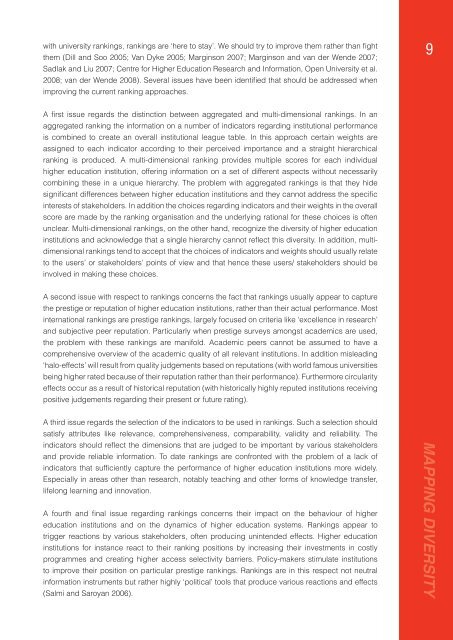Mapping Diversity: Developing a European Classification of ... - U-Map
Mapping Diversity: Developing a European Classification of ... - U-Map
Mapping Diversity: Developing a European Classification of ... - U-Map
Create successful ePaper yourself
Turn your PDF publications into a flip-book with our unique Google optimized e-Paper software.
with university rankings, rankings are ‘here to stay’. We should try to improve them rather than fi ght<br />
them (Dill and Soo 2005; Van Dyke 2005; Marginson 2007; Marginson and van der Wende 2007;<br />
Sadlak and Liu 2007; Centre for Higher Education Research and Information, Open University et al.<br />
2008; van der Wende 2008). Several issues have been identifi ed that should be addressed when<br />
improving the current ranking approaches.<br />
9<br />
A fi rst issue regards the distinction between aggregated and multi-dimensional rankings. In an<br />
aggregated ranking the information on a number <strong>of</strong> indicators regarding institutional performance<br />
is combined to create an overall institutional league table. In this approach certain weights are<br />
assigned to each indicator according to their perceived importance and a straight hierarchical<br />
ranking is produced. A multi-dimensional ranking provides multiple scores for each individual<br />
higher education institution, <strong>of</strong>fering information on a set <strong>of</strong> different aspects without necessarily<br />
combining these in a unique hierarchy. The problem with aggregated rankings is that they hide<br />
signifi cant differences between higher education institutions and they cannot address the specifi c<br />
interests <strong>of</strong> stakeholders. In addition the choices regarding indicators and their weights in the overall<br />
score are made by the ranking organisation and the underlying rational for these choices is <strong>of</strong>ten<br />
unclear. Multi-dimensional rankings, on the other hand, recognize the diversity <strong>of</strong> higher education<br />
institutions and acknowledge that a single hierarchy cannot refl ect this diversity. In addition, multidimensional<br />
rankings tend to accept that the choices <strong>of</strong> indicators and weights should usually relate<br />
to the users’ or stakeholders’ points <strong>of</strong> view and that hence these users/ stakeholders should be<br />
involved in making these choices.<br />
A second issue with respect to rankings concerns the fact that rankings usually appear to capture<br />
the prestige or reputation <strong>of</strong> higher education institutions, rather than their actual performance. Most<br />
international rankings are prestige rankings, largely focused on criteria like ‘excellence in research’<br />
and subjective peer reputation. Particularly when prestige surveys amongst academics are used,<br />
the problem with these rankings are manifold. Academic peers cannot be assumed to have a<br />
comprehensive overview <strong>of</strong> the academic quality <strong>of</strong> all relevant institutions. In addition misleading<br />
‘halo-effects’ will result from quality judgements based on reputations (with world famous universities<br />
being higher rated because <strong>of</strong> their reputation rather than their performance). Furthermore circularity<br />
effects occur as a result <strong>of</strong> historical reputation (with historically highly reputed institutions receiving<br />
positive judgements regarding their present or future rating).<br />
A third issue regards the selection <strong>of</strong> the indicators to be used in rankings. Such a selection should<br />
satisfy attributes like relevance, comprehensiveness, comparability, validity and reliability. The<br />
indicators should refl ect the dimensions that are judged to be important by various stakeholders<br />
and provide reliable information. To date rankings are confronted with the problem <strong>of</strong> a lack <strong>of</strong><br />
indicators that suffi ciently capture the performance <strong>of</strong> higher education institutions more widely.<br />
Especially in areas other than research, notably teaching and other forms <strong>of</strong> knowledge transfer,<br />
lifelong learning and innovation.<br />
A fourth and fi nal issue regarding rankings concerns their impact on the behaviour <strong>of</strong> higher<br />
education institutions and on the dynamics <strong>of</strong> higher education systems. Rankings appear to<br />
trigger reactions by various stakeholders, <strong>of</strong>ten producing unintended effects. Higher education<br />
institutions for instance react to their ranking positions by increasing their investments in costly<br />
programmes and creating higher access selectivity barriers. Policy-makers stimulate institutions<br />
to improve their position on particular prestige rankings. Rankings are in this respect not neutral<br />
information instruments but rather highly ‘political’ tools that produce various reactions and effects<br />
(Salmi and Saroyan 2006).<br />
MAPPING DIVERSITY

















